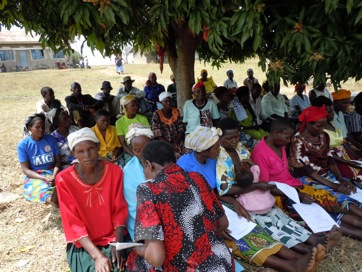July 2010 - March 2011
Last July, PAAP returned to conduct the second of three trainings in the Districts of Kamwenge and Rakai, believed to be where the HIV/AIDS epidemic began in Uganda. Although the average HIV prevalence rate in Uganda has been reduced to 6.4%, in Rakai and Kamwenge it remains as high as 12%.
The trainings took place at the Kyotera and the Kamwenge Health Centres, where 32 nurses, nursing assistants, and midwives returned to increase their knowledge and improve their skills (bringing the total number of Ugandan Trainees to 234). The Trainees reported that, since the first trainings, they had had great success with acupuncture in their places of work. Impressive and encouraging were the many cases in which patients suffering from splenomegaly (enlarged spleens) due to improper or incomplete malaria treatment reported significant reduction in pain and reduced swelling.
During the December trainings, we continued to see the wide support of our work and the need for our services and the work of our Trainees. In Kamwenge, most mornings we were greeted by hundreds of patients waiting for treatment. Patients traveled from great distances, and many of them slept overnight in the clinic to ensure that they would receive acupuncture treatments in the morning.

By the end of the week, Trainees and Trainers were working nonstop, providing treatments both in the clinic and outside under the broad trees in the adjacent field. Over the course of the two weeks, the Trainees provided almost 1000 treatments. These districts now have health-care providers who are able to treat the population with acupuncture, making them unique among their peers and much sought after by those seeking relief from their debilitating symptoms.
As the international media has reported, funds that have been used to support the distribution of AIDS medicines are being reduced. The United States Agency for International Development (USAID) and the US President's Emergency Plan for AIDS Relief (PEPFAR) are significantly reigning in their help. Because of this, newly diagnosed individuals in Uganda may be denied access to their medications.
Thus, it is even more important that PAAP continues its important work—training health workers how to provide care when otherwise there may be none.
In late February, we returned to Uganda and visited five districts were we had have previously worked. The Trainees related many breathtaking stories. Many of them reported how their acupuncture treatments have led to a significant reduction in size and pain from grossly enlarged spleens, a malaria-related condition previously untreatable. Trainee Hussein spoke of one of his AIDS patients who, because of his acupuncture treatments, was once again able to walk. And David described how his treatments have greatly reduced the severity and frequency of epileptic seizures.
These are but a few among many stories of how acupuncture has been helping the people of Uganda. When drug supplies run out or when they fail to address the many debilitating symptoms rampant among Ugandans, acupuncture has become the effective treatment of choice.
PAAP continues to demonstrate how powerful acupuncture can be and how teaching practitioners how to use this simple, effective treatment modality leaves them feeling empowered and deeply satisfied. And most important, the people of Uganda continue to benefit from PAAP and its Trainees.
 Support our Work.
Support our Work.Return to Progress to Date page.





 113 Summit Avenue
113 Summit Avenue